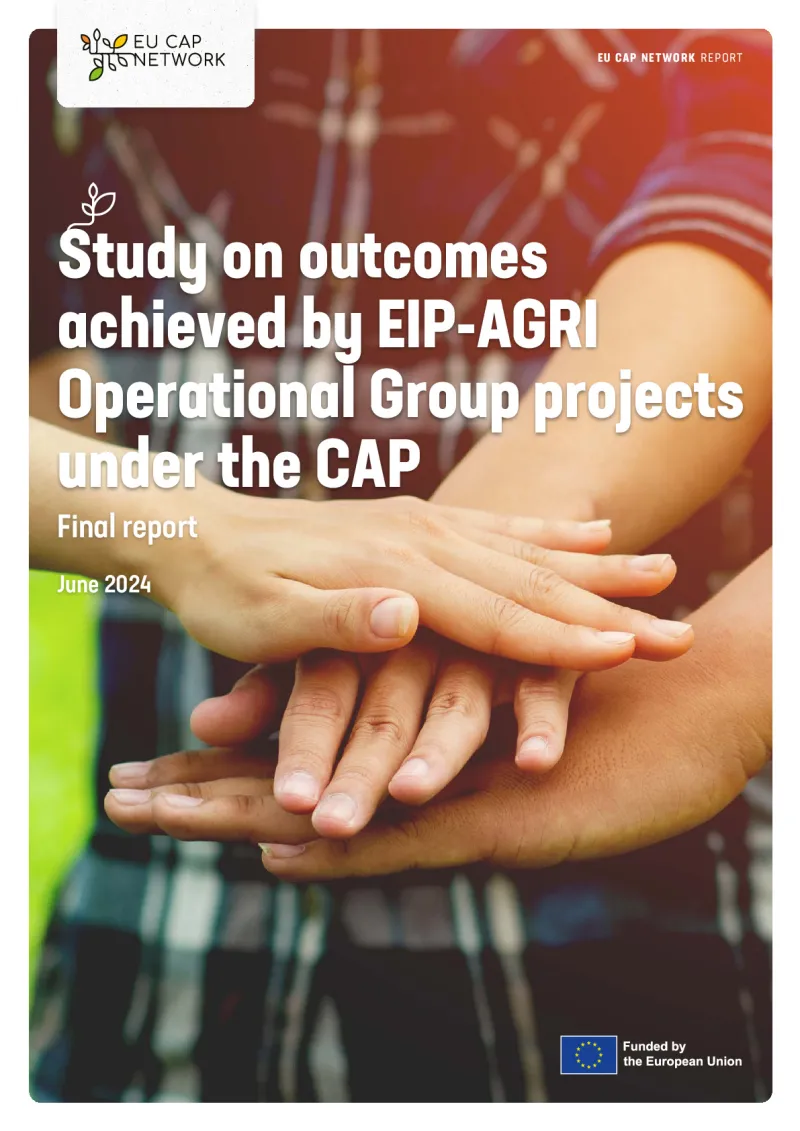New study on EIP Operational Groups: cooperation is key for innovation
- Innovation, knowledge exchange & EIP-AGRI
- Evaluation
- Evaluation
- Fostering Knowledge & Innovation
- Cross-cutting Impacts
- Socio-economic Impacts
- AKIS
- Economic impacts
The ‘Study on outcomes achieved by EIP-AGRI Operational Group projects under the CAP’ aimed to understand better how Operational Groups (OG) operate, how they design and run the processes of co-creation of innovation, and how they spread innovative solutions.

The study was coordinated by the Evaluation Helpdesk of the EU CAP Network from September 2023 to June 2024. It assessed the outcomes of Operational Groups (OG) projects, and aimed to identify the main drivers and barriers to achieving these outcomes, including the contribution of communication and dissemination activities and the role played by calls for European Innovation Partnership (EIP) projects.
The study was based on case studies and two surveys, respectively targeting Operational Group partners, and EIP/innovation stakeholders across the whole EU. The OG survey allowed the collection of 989 completed questionnaires from 24 Member States and the UK, corresponding to 768 OG projects. The innovation stakeholder survey collected a total of 233 completed questionnaires. Moreover, 15 OG projects across several Member States have been selected as case studies.
OGs are the EIP's backbone, bringing innovation into the agroecosystem and improving its connection with research. They bridge research and farming practice by bringing together AKIS actors, such as farmers, advisors, researchers, businesses, NGOs and others, to promote innovation processes and knowledge exchange in agriculture and forestry.
A central element of OGs is the interactive work between partners with complementary expertise serving the common objectives of the OG innovation project. OG partners collaborated to capture grassroots ideas and co-create innovative and practical solutions for the identified needs or challenges. They also went beyond their project and networked with other OGs or Horizon Europe research projects, which helped further boost knowledge.
The first highlight of the study is the variety of innovative solutions produced by OGs according to their planned objectives. These solutions encompass agronomic practices and process innovation, technological innovation, knowledge exchanges, product innovation, service innovation, and organisational and rural social innovation.
One key factor that stands out as a driver of success is the composition of OG partnerships. Partnerships with a balanced mix of (complementary) expertise, practical experience and knowledge involving farmers, foresters, and other end-users are crucial for the success of the projects. At the same time, the ‘interactive innovation model’ has proved to be a key approach for achieving OG outcomes. Evidence from specific projects indicates that the most successful projects were those whose partners had cooperation experience, and those that promoted active involvement of all partners and effective communication amongst relevant stakeholders. This has been observed in OG projects where all partners contributed to the decision-making and implementation processes, establishing good internal communication and close collaboration with innovation brokers and other facilitators.
OG projects are not limited to co-creating innovative solutions, but one of their main objectives is to share project outcomes and disseminate them to the largest possible number of end-users who can benefit therefrom. Evidence shows that most innovative solutions produced have a high potential to be transferred and upscaled. This means they can be implemented on a larger scale, for instance, outside the OG partnership or to create new opportunities through improved quality or product diversification. This transferability can spread even further, and many OG projects have demonstrated the potential to strengthen innovation-oriented communities.
Several factors contribute positively to scaling up innovation. The study results highlight the importance of showcasing the benefits and practical use of innovative solutions, particularly through on-farm demonstrations and peer-to-peer events.
Dissemination involving interactions among end-users and other stakeholders emerges as the most effective tool. Reaching out to end-users, choosing the right dissemination channels, and continuing collaboration between partners after the project's end proved to be important facilitating factors for transferring and scaling up OG project outcomes.
Lessons also come from less successful cases, where it is shown that lack of focus on end-user needs when designing the objectives of the OG projects can be detrimental to the co-creation and spread of an innovative solution, which risks being relevant only for a limited number of end-users. Furthermore, inadequate training and advisory systems or lack of demonstration farms limits the potential for disseminating innovations.
OGs do not operate in silos. Communication and dissemination activities are crucial for creating opportunities outside the OG partnership and spreading OG project outcomes. Evidence from the study shows that the key elements for effective communication and dissemination include active communication throughout the project life cycle and beyond. The presence of an advisor or a communications expert in the OGs could be beneficial in increasing awareness of the importance of communication. Managing Authorities and National Networks are important multipliers/disseminators of information, mainly through their websites and events.
The last element analysed in the study is the EIP OG calls, and how the approaches used in different Member States favoured or limited the achievement of OG outcomes. In many cases, Managing Authorities have sought a balance between the need to encourage grassroots ideas and the need to keep the focus on the strategic priorities of Rural Development Programmes. They have often achieved this through the combined use of so-called open calls (calls without a predefined theme) and thematic calls.
According to the study findings, the used approaches of open/thematic calls have generally met the objective of targeting both grassroots and theme-driven needs
In most cases, the eligibility conditions and selection criteria of EIP OG calls favoured the gathering of partners with complementary expertise and promoted equal participation of all OG partners, which in turn has facilitated the co-creation of innovative solutions.
“The creation of the OG partnership behind an innovation is often a more important success factor than the innovation itself”, highlighted one of the interviewees in Sweden.
Overall, EIP OG calls can be instrumental in co-creating and spreading innovative solutions. Lessons from existing calls highlight the value of a preparatory phase when structuring OG calls: allocating time, tools and funds for thorough preparation is a crucial success factor for OG projects.
Evidence also suggests that calls requiring structured planning and implementation of communication and dissemination activities positively impact the achievement of project outcomes. In addition, call requirements need to be targeted, and excessively complex rules must be avoided because they generate excessive burdens on beneficiaries and administration.
Many OGs expressed concern over administrative burden and certain administrative procedures, mainly linked to reporting rules, the long wait time to receive payments, and limited flexibility in the implementation process. To reduce administrative burden, simplification can be further developed, for instance through wider use of simplified cost options. Additionally, payments to farmers for the time they spend working for the OG project could increase their interest and active participation in such projects.
In conclusion, the study confirmed the positive contribution of EIP OGs to advance innovation in the agriculture and forestry sectors. This contribution is possible thanks to multi-actor partnerships with complementary expertise interacting to co-create innovative solutions that can be spread using the most effective dissemination channels.
Read the full report 'Study on outcomes achieved by EIP-AGRI Operational Group projects under the CAP' in the EU CAP Network publications database.
